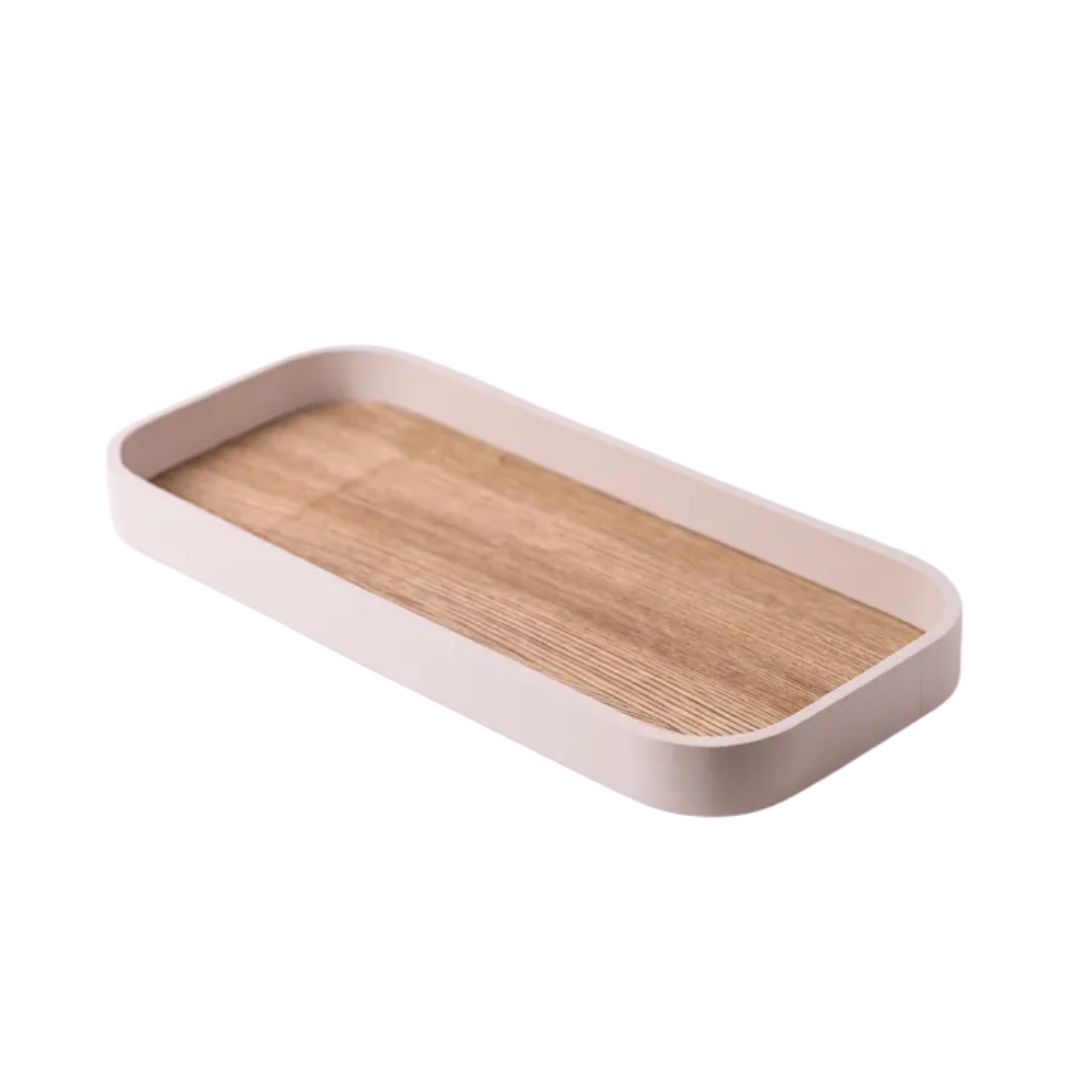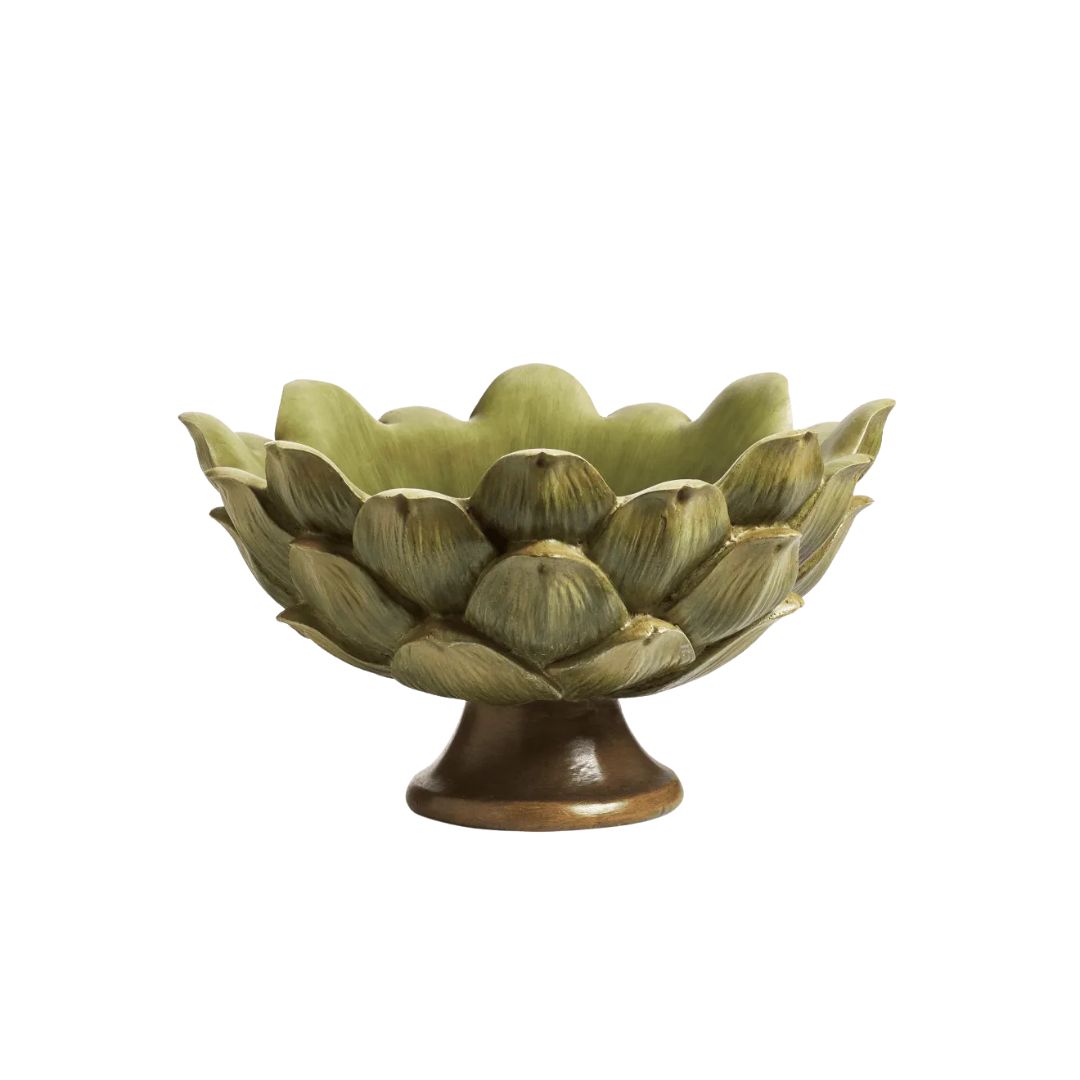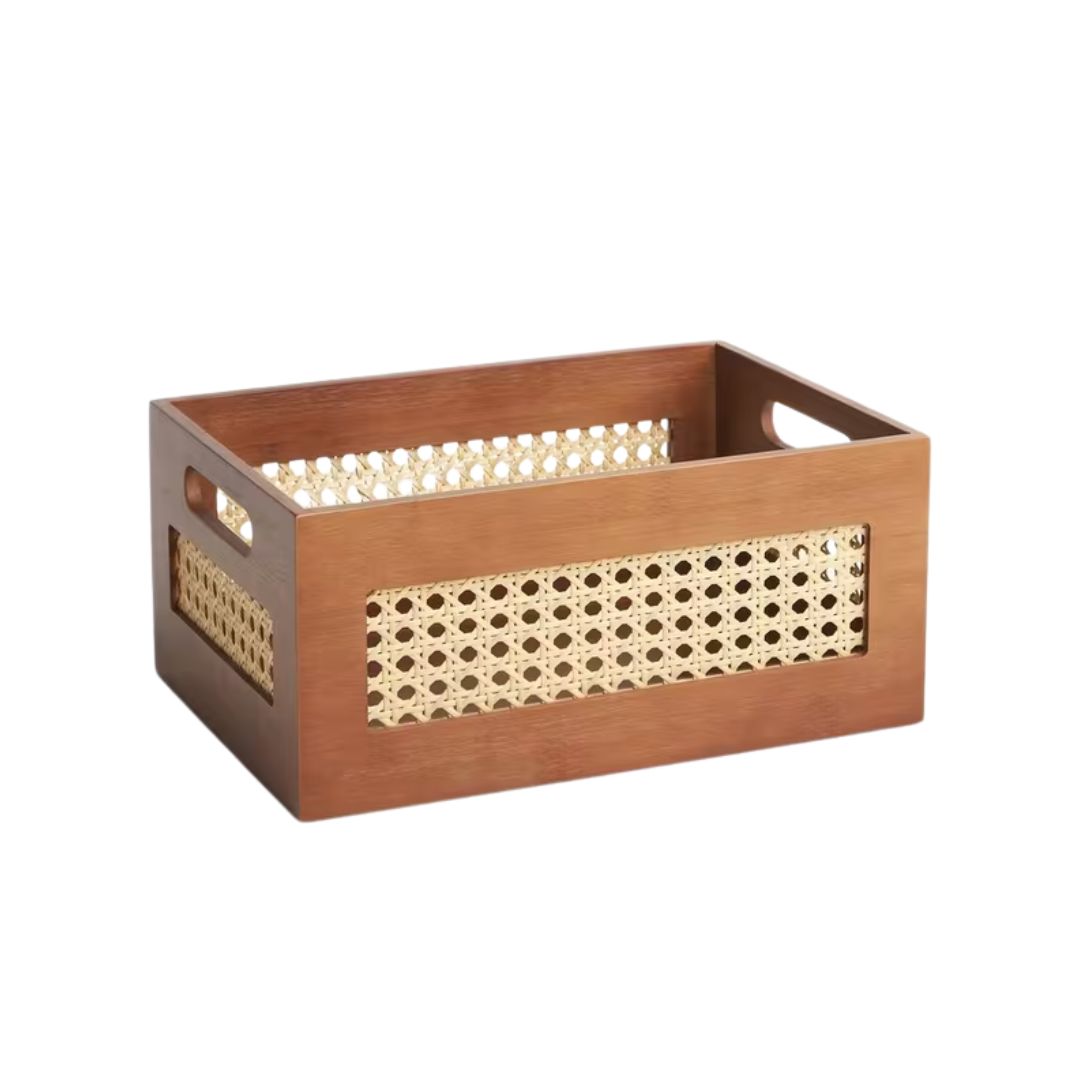10 Ladder Kitchen Cabinet Ideas That Make the Most of High Storage and Make Your Scheme Feel Classy
Rail ladders in a kitchen have a sort of elegance to them that's hard to ignore, but they're also practical for storage, too
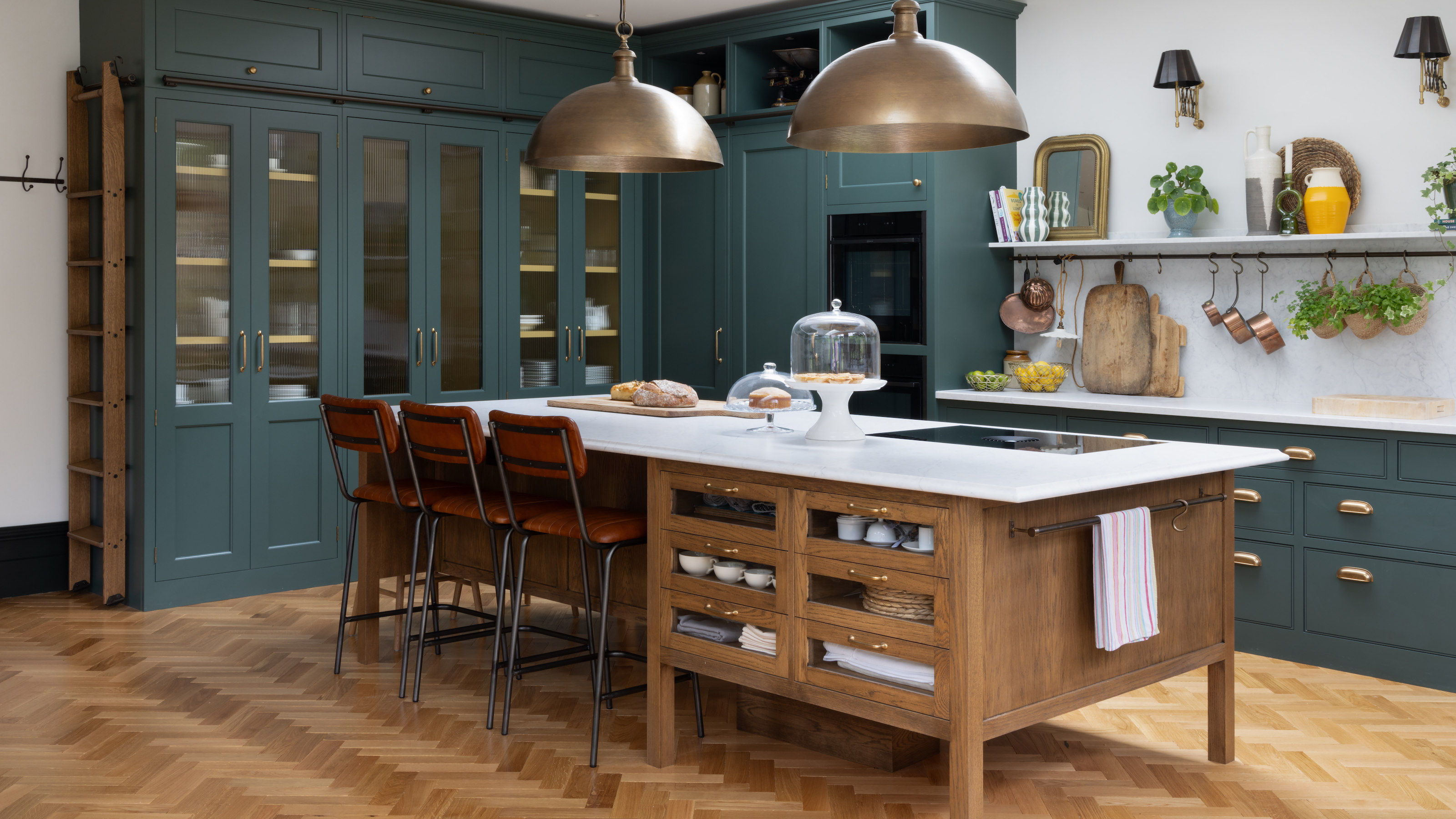
Who says ladders are just for accessing the loft or cleaning gutters? In the world of kitchen design, ladder cabinets turn everyday storage into a vertical adventure, finally making sky-high storage useful for stashing all the seasonal stuff clogging up your main kitchen cabinets.
"For kitchens with floor-to-ceiling cabinetry, including a library ladder, ideally with a ladder rail, is an ideal way to access all hard-to-reach top boxes and overhead cupboards. It is also an attractive and sophisticated addition to any kitchen design," says Tim Higham, founder of Higham Furniture.
This trend draws inspiration from industrial loft ingenuity and the timeless allure of library ladders. Today’s kitchen ladders share a similar spirit, turning a smart access solution into a stylish design feature. They can blend vintage industrial elements, colorful moments, and contemporary design twists, all in the name of making your kitchen fully accessible from floor to ceiling.
Ready to reach new heights in kitchen design? Discover our 10 ladder kitchen cabinet ideas, which brilliantly combine practical storage with a sense of adventure. Acrophobics, look away.
1. Color Coordinate
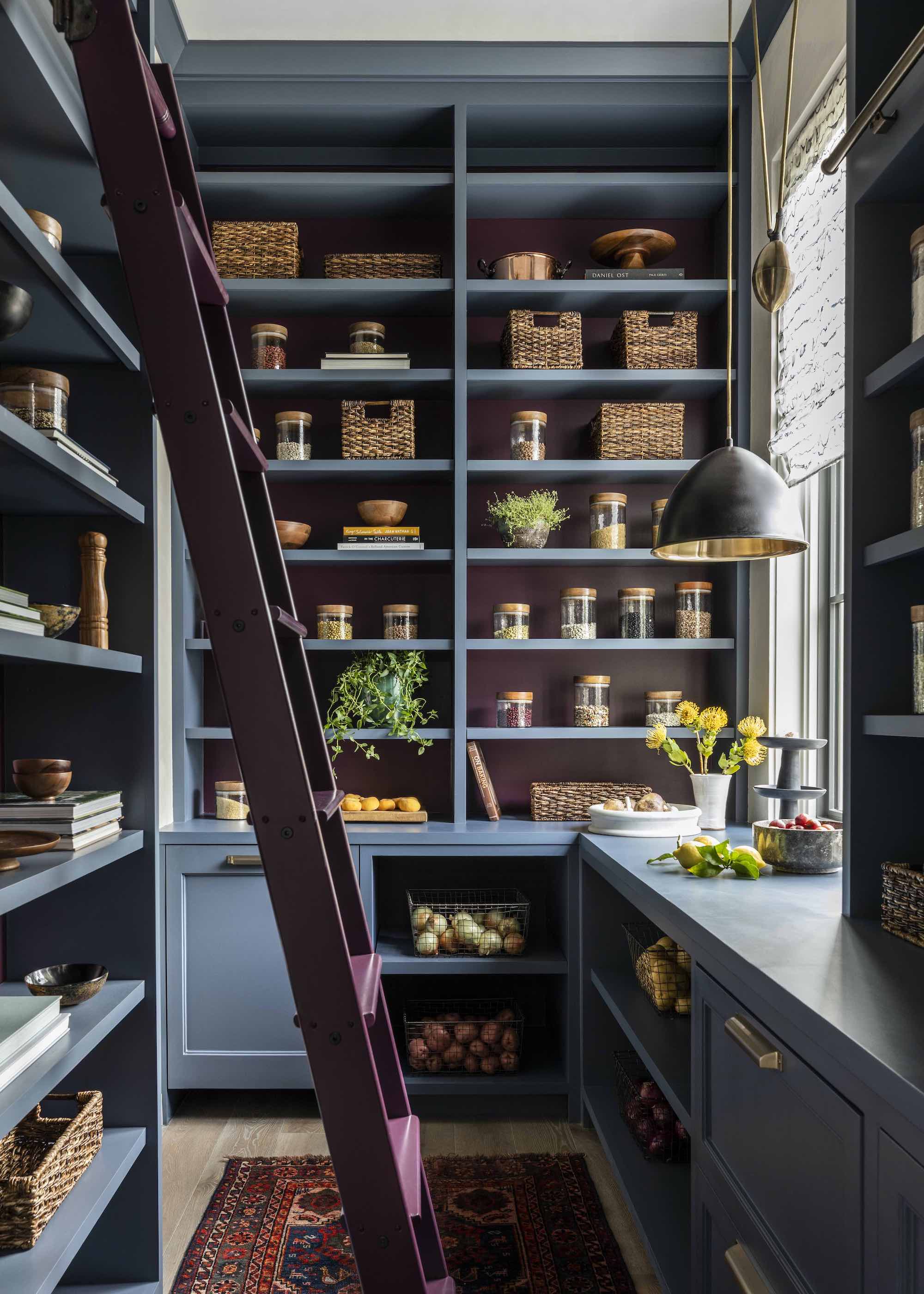
This aubergine ladder is a punchy color play.
Color-matching your ladder doesn’t have to mean it disappears entirely — it can also be a clever way to add richness and depth to your scheme. In this handsome space by Benjamin Johnston, the rolling library ladder is colour-matched to the aubergine walls behind. It's certainly a color you won't get tired of.
Painted in punchy SW 2704 Merlot by Sherwin-Williams, the ladder fits cohesively into the space, enhancing the visual flow but without standing out as a separate element. "A color-coordinated ladder becomes an integrated functional feature rather than a distracting accessory," agrees Benjamin.
In paler, more neutral kitchens, a similar two-tone coordinated approach will ensure the ladder feels harmonious and intentional. Even timber kitchens can work this look; a wooden ladder stained to match the cabinetry’s wood tones will add warmth and consistency.

Houston-based Benjamin Johnston has been creating eloquent interiors for nearly two decades. Benjamin’s architectural background shines through every extraordinary luxury residential project he and his talented team tackle, and he’s also an established product designer and has collaborated on the design of furniture, rugs and textiles for various high-end brands.
2. Metal Works
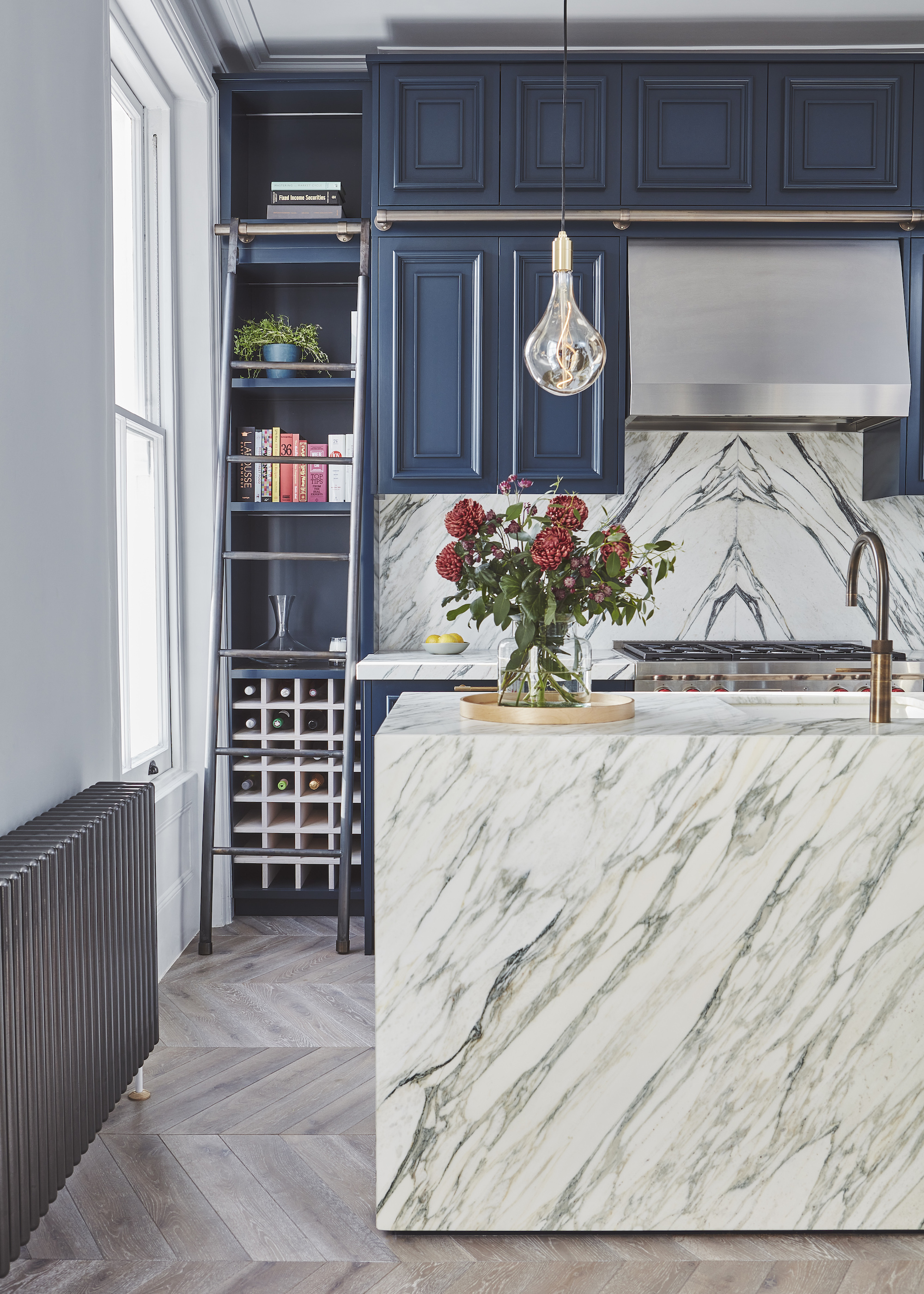
A metal ladder will take things in a more modern direction.
Concerned that your traditional modern kitchen ideas might be teetering towards too conventional? Consider integrating a metal ladder to infuse your space with a fresh, industrial edge.
In this innovative design by Blakes London, a striking metallic ladder and coordinating ladder rail not only break up an expanse of wall but also tie together finishing touches with the range cooker and hood. "The bronze ladder added a distinctly industrial charm to the overall design," says lead designer Ash McCullough.
While metal ladders generally come with a higher price tag compared to simpler wooden counterparts, particularly when custom-designed, they offer a significant practical advantage. "Their lightweight, hollow tubular construction is especially useful for taller ladders, which, when crafted from timber, can be unwieldy to reposition without the support of wheels," explains Ash.

Ash discovered her passion for colour, texture, and materiality while studying Interior Architecture and Design at the University of Essex. She refined her skills at a bespoke joinery studio in Ireland before moving to London. After spending three years with an interior design studio, she now delights in guiding clients from concept to complete design at Blakes London, balancing functionality with aesthetics.
3. Make the Most Out of High Ceilings
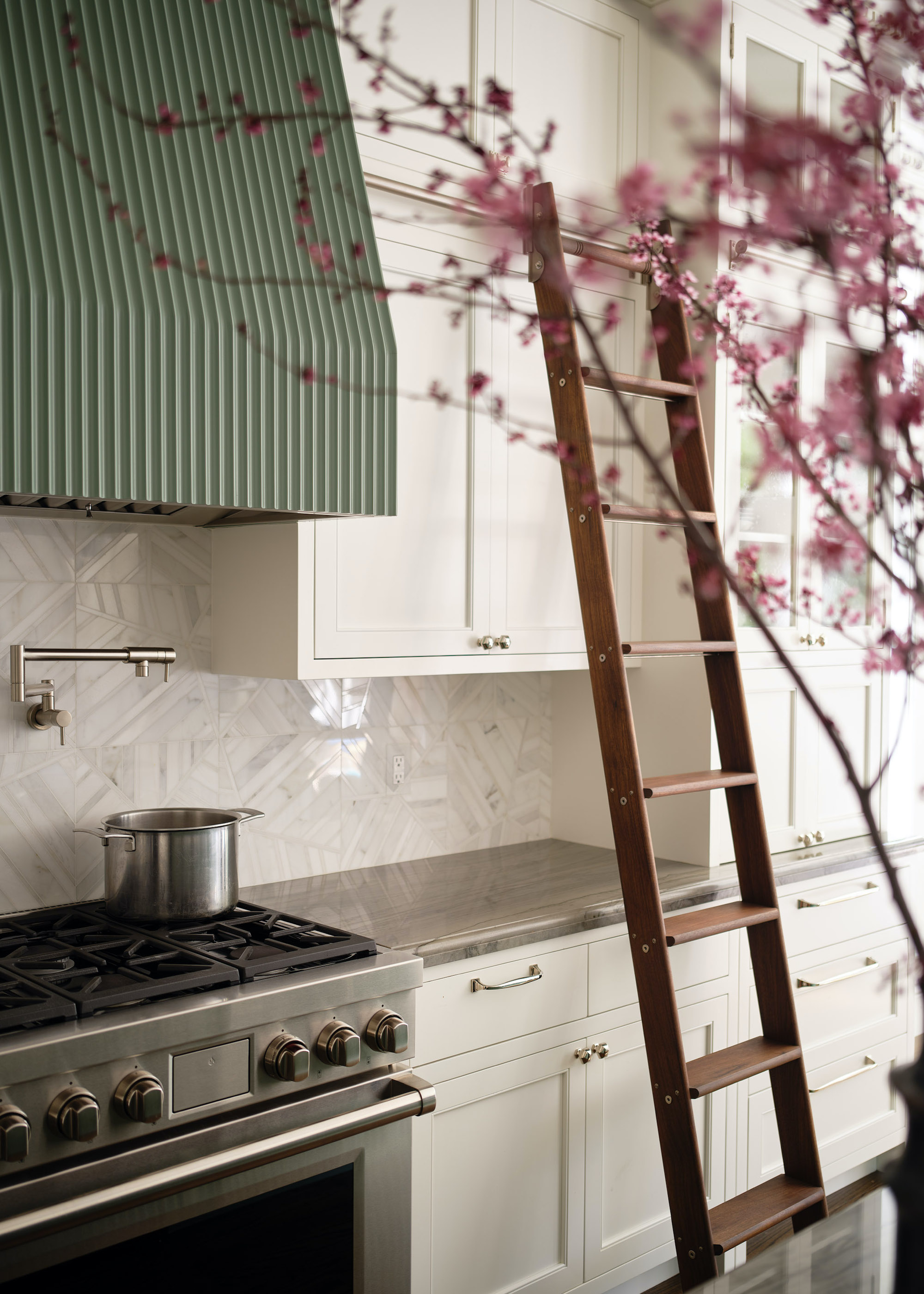
Gorgeous timber adds a classy touch in this transitional space.
If you’re blessed with high ceilings, do not miss the opportunity to brag about your good fortune! A well-placed ladder will accentuate those vertical benefits and draw the eye upward to celebrate your kitchen’s full spacious glory and make the most of your kitchen storage.
In this collaborative project by Alicia Cheung Design and Eva Bradley Studio, a traditional wooden ladder does just that. "With the high ceilings, we extended storage all the way up to draw the eye upward and create a sense of grandeur," explains Eva. "The ladder not only adds a functional element but also brings a warm, library-like feel, making the kitchen feel more inviting and cozier."
The ladder’s design was carefully selected to echo the property's Victorian charm. "We chose something a bit nostalgic in style because the property’s architectural character is Victorian," recalls Alicia. "We wanted something timeless with a twist, and this ladder style was perfect for our goals."
4. Make It Stand Out
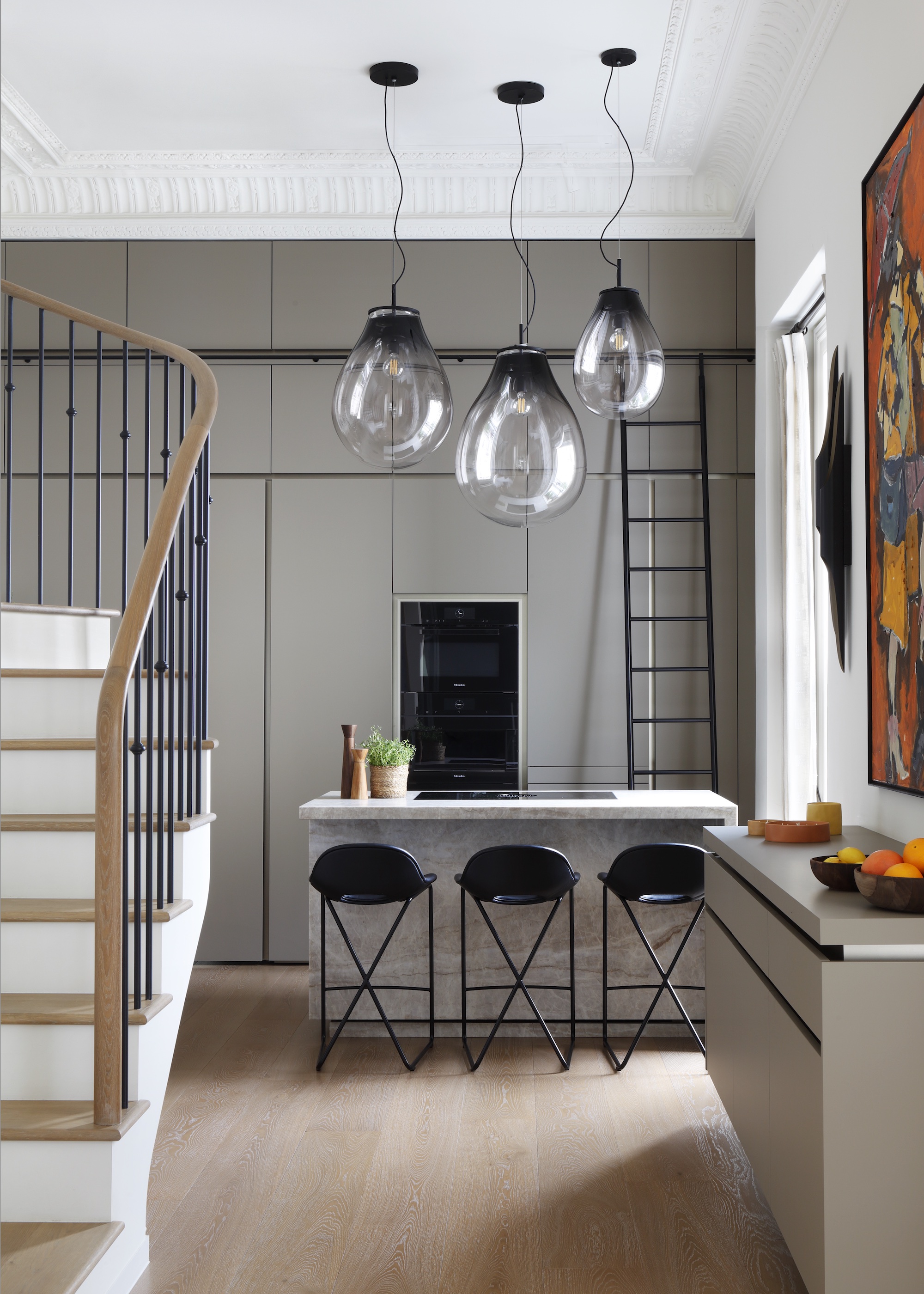
Strike a strong silhouette with a black ladder on grey cabinets.
Want a ladder that really pops? Go for a dark finish against light cabinetry – it’s the ultimate contrast move. The bold silhouette instantly catches the eye, adding depth and drama without trying too hard. It’s a simple way to turn a functional piece into a standout design feature, giving your kitchen that cool, curated edge.
Ciara Ephson clearly got the memo in this open-plan apartment, where a dark bronze ladder adds serious style points against a backdrop of cool gray cabinetry. "We wanted the ladder to stand out, but still feel like part of a bigger story," says the director of Fentiman Design.
"The dark bronze finish echoes other details throughout the flat –curtain poles, stair spindles, door handles, etc – so even though it’s a statement piece, it feels totally cohesive in the space." The result is a bold, unified look that anchors the kitchen at the star of this space.
5. Get Inside Access
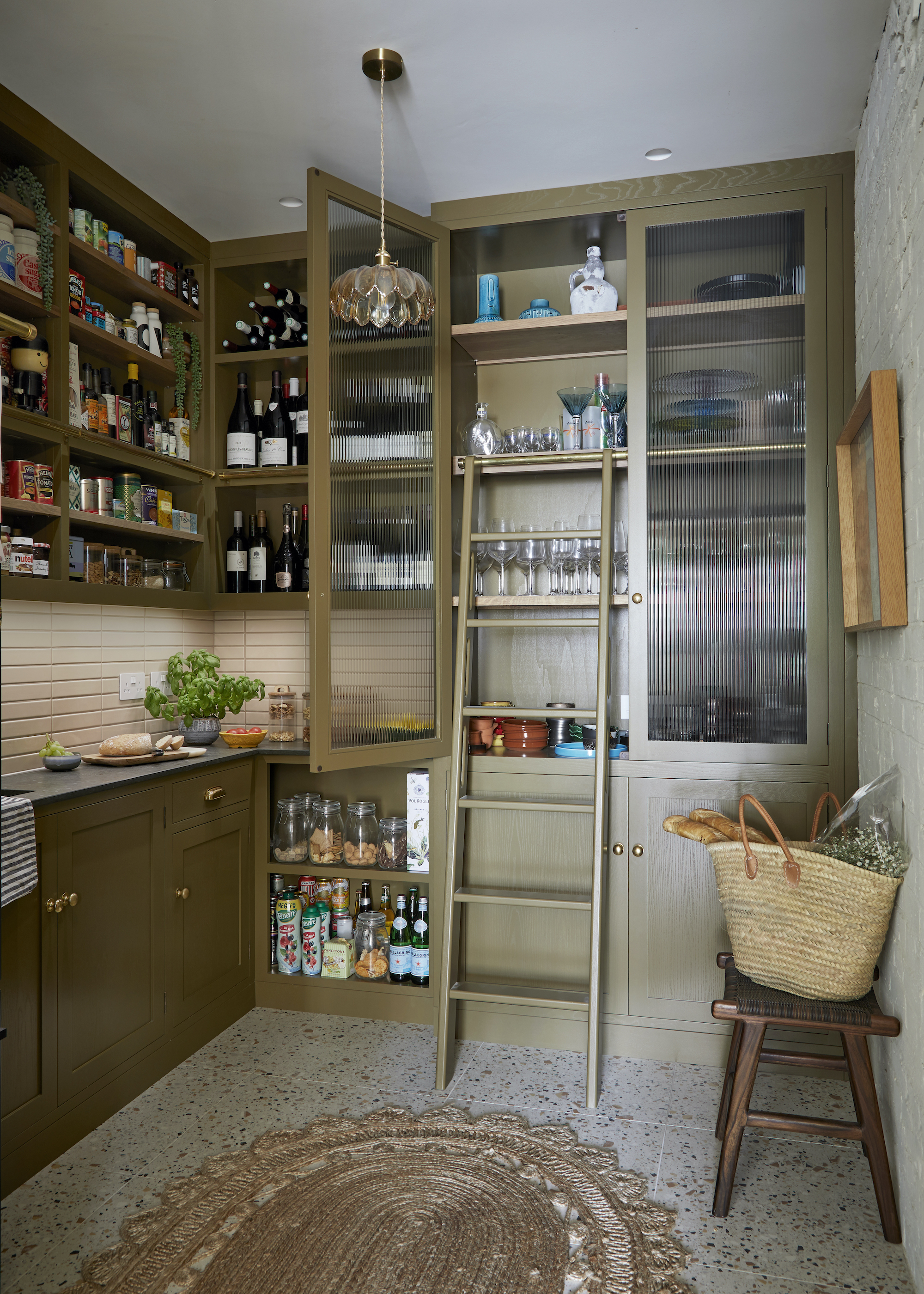
Continue your ladder access with an internal rail.
No kitchen ladder is complete or safe without a properly installed rail. A ladder rail provides the essential support needed to keep the ladder firmly in place, allowing you to reach high cupboards with confidence and without the risk of it slipping out from under you. But beyond safety, it’s also an opportunity to add a design detail that ties the whole space together.
In this clever design by Fiona Duke Interiors, the brass ladder rail doesn’t stop at the main cabinetry — it continues seamlessly into the dresser unit for uninterrupted access. "By setting the kitchen shelving unit on this level back slightly, we were able to accommodate the brass rail to sit neatly behind the door when not in use," says Fiona. "The ladder is stored in a gap between units and fridge [out of shot], so that it only needs to be out when required for the top shelves."
It’s a thoughtful and practical solution that ensures every inch of storage is accessible, while keeping the ladder out of sight when not required.

Fiona Duke is an award-winning Interior Designer specialising in high-end residential renovations. Using a mix of modern and vintage styles, Fiona creates inspirational, elegant spaces with a relaxed 'effortless' aesthetic. She believes that designing with a mix of styles creates a far more authentic way of living and helps to embrace the beauty of the 'imperfect' into every design.
6. Stash It Away
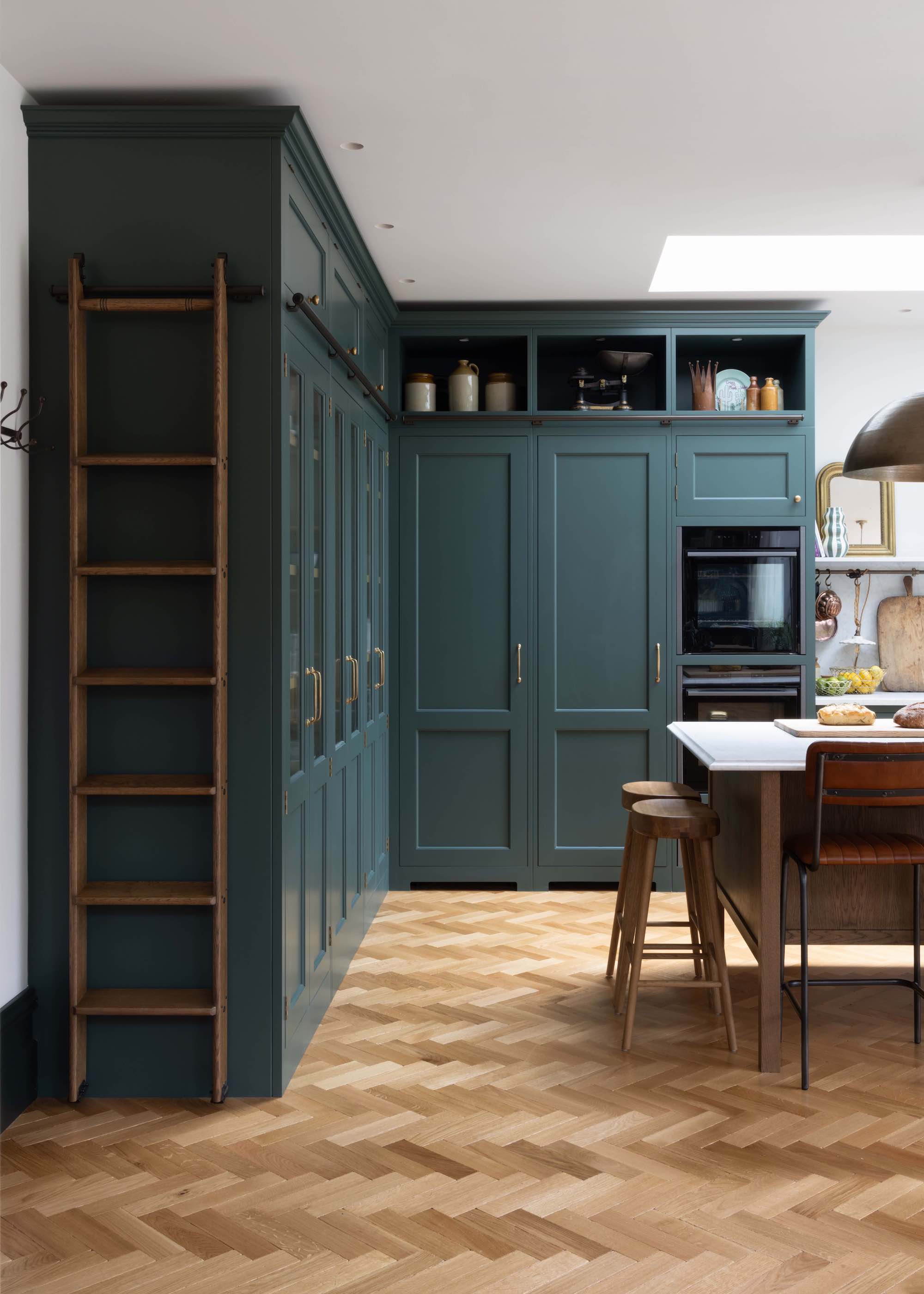
An end run is a great place to show off your lovely ladder when not in use.
Ladders make a fabulous modern interior design statement, but without a smart storage solution, they can quickly become a nuisance — cluttering walkways, interrupting flow, and generally getting in the way. In other words: a total pain.
The fix, says Higham Furniture founder Tim Higham, is to plan a dedicated, out-of-the-way spot to stash your ladder that’s still easy to access when needed. While there are clever specialist options – think pull-out systems or behind pocket doors – the simplest (and often most elegant) solution is to hang it on the end of a cabinet run.
"This method requires two sets of hooks at the top of the ladder. One that hooks over the main hanging rail to access top cabinets safely," Tim explains. "When no longer required, a second set of hooks below the top rail hook are then used to attach the ladder to a smaller independent rail at the end of the cabinetry run, allowing it to be stowed vertically without reaching the floor, or getting in the way. The result is an end panel that is both functional and interesting to look at, while the main kitchen cabinets are then obstacle-free."

Tim Higham is the founder of Higham Furniture, a London-based company known for its bespoke handmade Shaker kitchens, from classic to contemporary. Founded in 2004, it has a Fulham studio and a workshop in Hampshire, and also creates walk-in pantries and utility rooms. The brand champions sustainability, partnering with Little Greene on an exclusive range of eco-friendly paints.
7. Take It Down Low

Mini ladders are super cute and just as useful.
Kitchen ladders don’t have to be soaring designs that are top-heavy and unwieldy. A shorter design can be small but mighty, particularly in compact kitchens or pantries where a full-size ladder would simply be OTT.
Louisa Eggleston, creative director at Humphrey Munson, explains: "Low-level ladders are ideal for accessing upper shelves in tight or confined spaces where a tall ladder would be cumbersome or overkill. They're more stable, easier to store, and so much easier to manoeuvre around especially in a small space."
This one is finished in Portman oak by Humphrey Munson as part of their bespoke ladder and rail system used in Humphrey Munson pantries and other rooms such as boot rooms. While a short ladder won’t give access to the very highest cupboards in a tall kitchen, its charm lies in its convenience and elegance, especially when beautifully crafted in a smart finish.
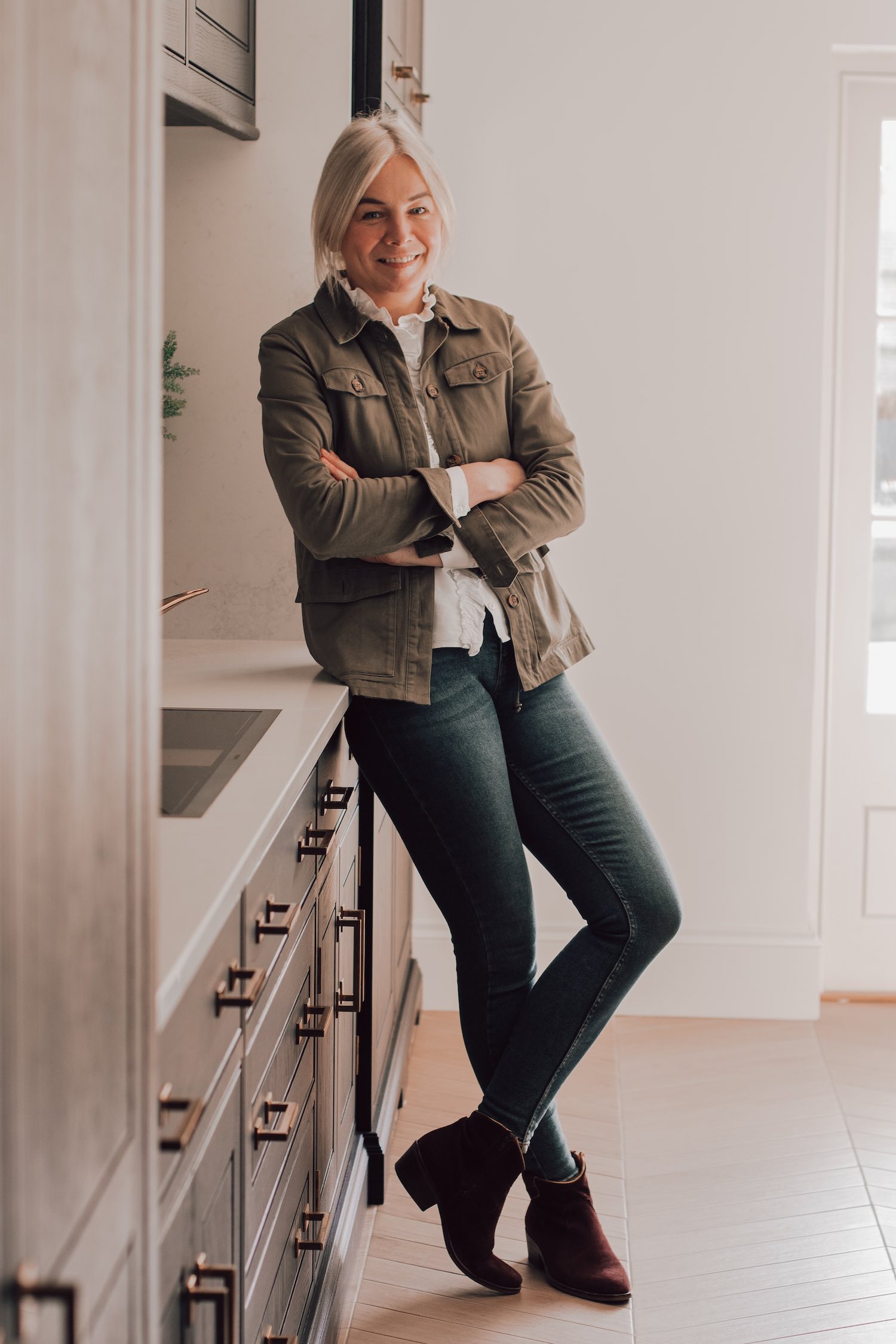
Louisa Eggleston is the Creative Director at Humphrey Munson, where she has worked for more than a decade. Holding a law degree from Durham, she began her career as a solicitor before transitioning into the creative field. Now, she leverages her impressive skills in visual communications to lead the creative team, blending modern aesthetics with the brand’s enduring heritage in every project.
8. Wheel It Along
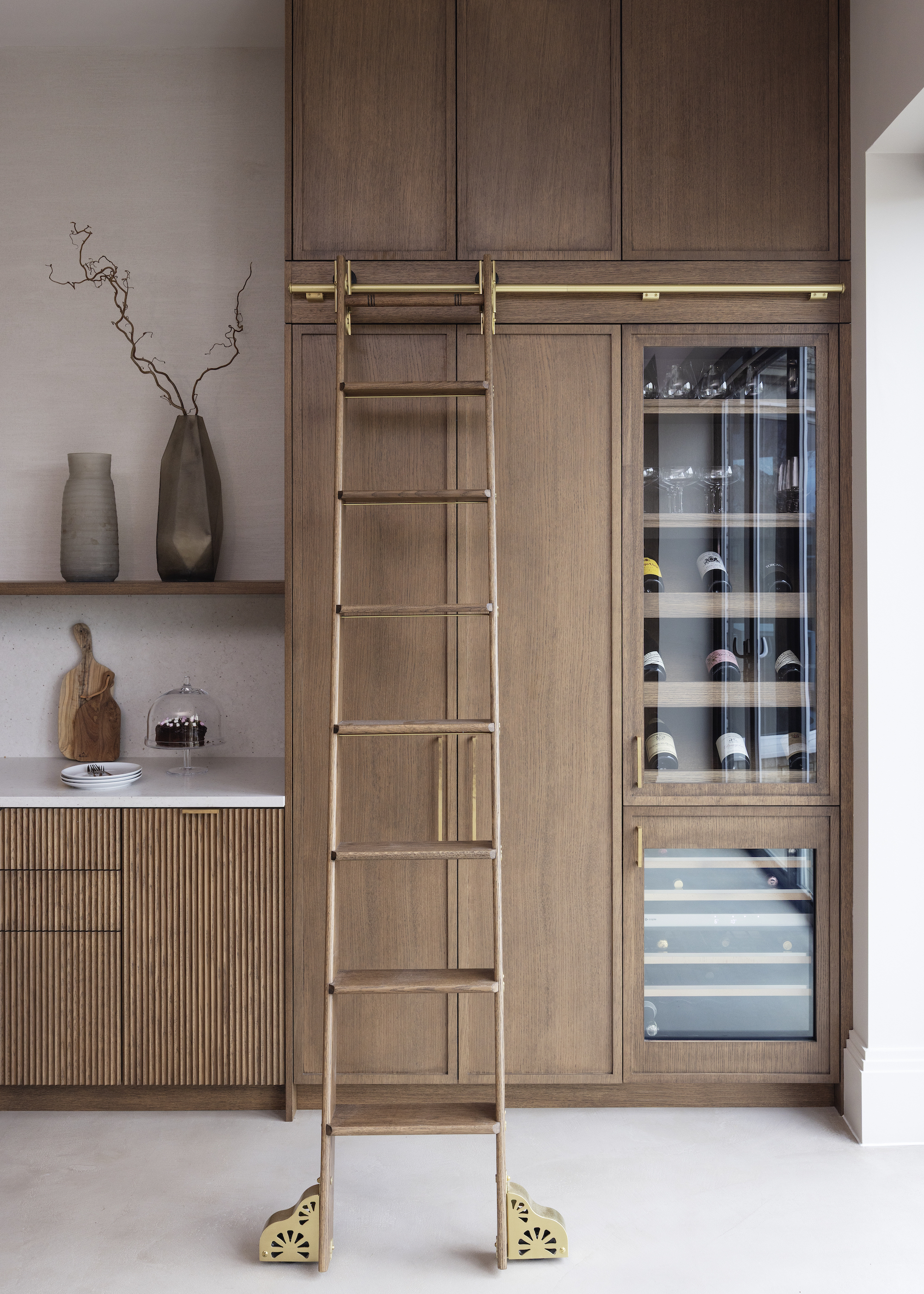
Glide your ladder along by adding pretty brass wheels.
A ladder on wheels sounds super fancy and in this example, looks pretty fancy too – but it can also be a really practical choice, especially if your upper body strength isn’t ideal. "Opting for a kitchen ladder with a wheeled base offers superb flexibility, allowing it to glide effortlessly across the floor for quick, convenient access," explains Felix Milns, founder of HUX London. Look for wheels that lock securely to prevent slipping while in use.
When adding wheels, it’s important to get the right rolling system at the top of your ladder. Classic rolling hardware is permanently fixed to the ladder rail, with two rollers on each side of the ladder for a really smooth gliding motion from left to right. However, they can’t be moved off the rail, so they are only suitable for one elevation of cabinets.
If you want to use your ladder on more than one wall, you’ll either need hook rolling hardware, which allows a wheeled ladder to hook on and off to be repositioned elsewhere. Or corner rollers, which work on a ladder rail that bends around corners so the ladder can glide smoothly along to the adjacent wall, perfect in an L-shape or U-shape kitchen layout.
9. Climb In Comfort
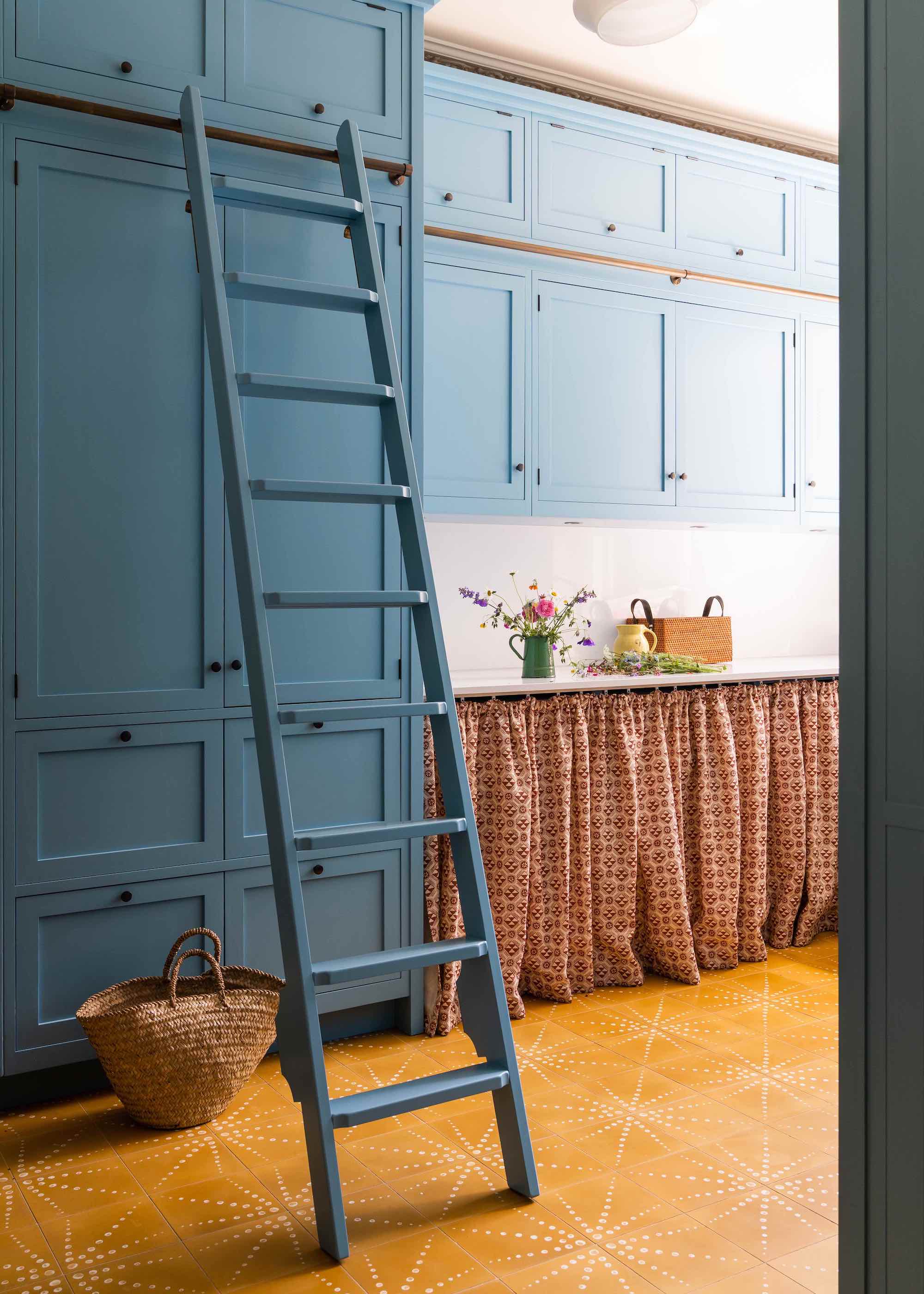
Deep treads are comfier, especially on bare feet or slippers.
When it comes to choosing between deeper treads and round rungs on a kitchen ladder, comfort and usability often tip the balance in favor of the former. "We have found that deeper treads are much more comfortable to use without shoes than rounded rungs and, as this ladder is in an interior setting, it was likely that family members would want to use it barefoot or in socks/slippers," explains interior designer Kate Guinness. "The deeper treads are also a bit more stable to stand on whilst rummaging around in cupboards."
While round rungs can lend a more classical or industrial aesthetic and take up slightly less visual space, deeper treads provide a more secure and comfortable footing, especially important in family homes where children might find clambering up a ladder impossible to resist. Yes, they can add a little more bulk to the ladder design, but the extra stability and comfort are well worth it.
10. Space-Saving Features
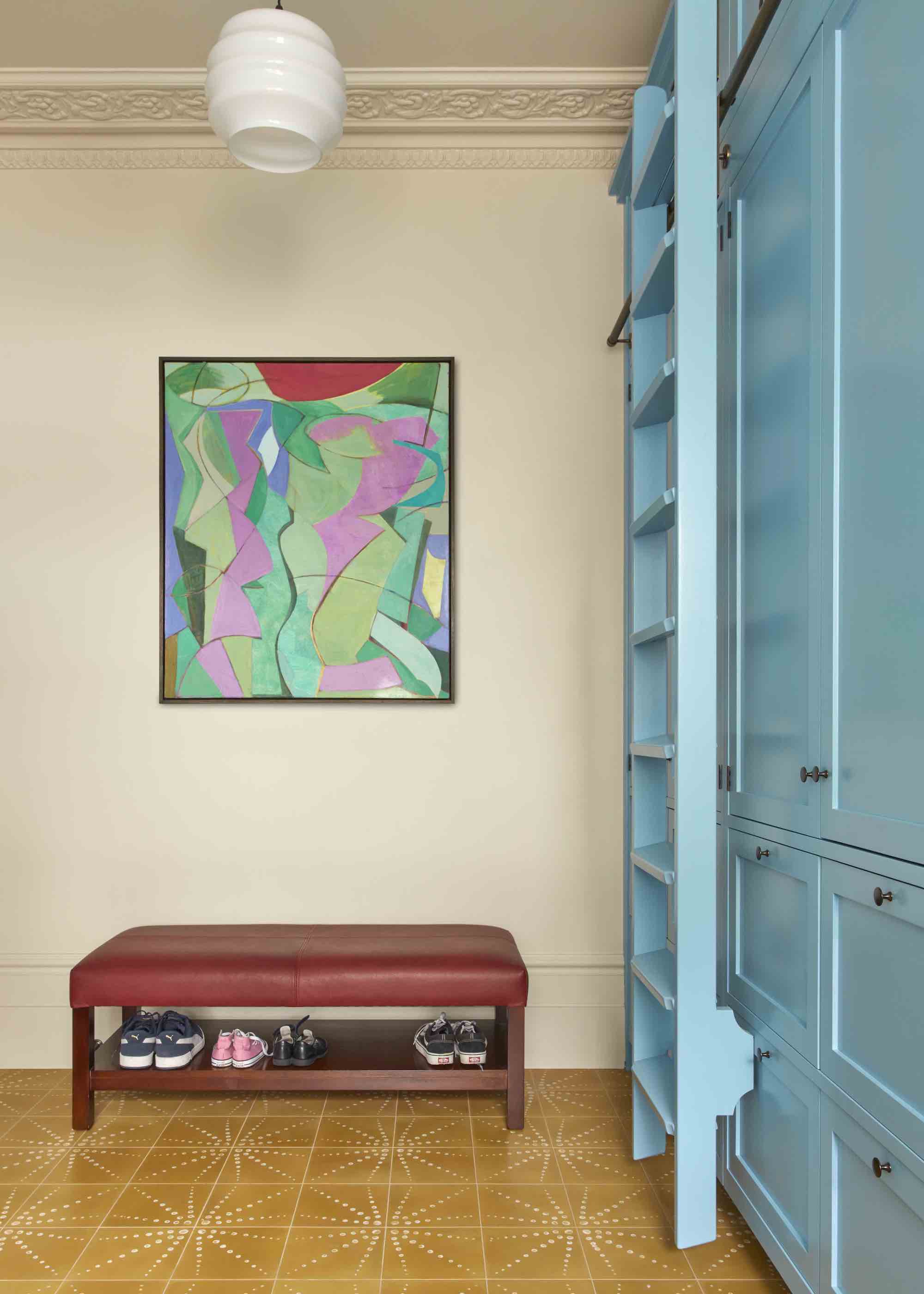
Tuck it out of the way when not in use.
In small kitchens, every inch of floor space counts, so having a ladder that can be stored tightly against the wall is a real advantage. Interior designer Kate Guinness highlights the importance of thoughtful design: "This ladder has a pair of hooks near the top so that it can be hung up on the rail and not get in anyone’s way – the shaped detail towards the bottom stops it from bashing against the cabinets when in this position."
Being able to hang the ladder flat against the wall or cabinetry keeps the space clear and clutter-free, while still allowing quick access to the ladder whenever required. It’s a simple but clever solution that blends practicality with design sensitivity, especially in kitchens where space is as tight as a tick.
FAQs
What Is the Next Trend for Kitchen Cabinets?
The next trend in kitchen cabinets is all about relaxed vibes and layered design, with arched kitchen cabinets leading the way. These gentle curves bring a sense of elegance and architectural interest to the kitchen, helping to disrupt the rigid, linear look of traditional cabinetry. Whether used for upper cupboards, pantry doors, or open shelving nooks, arches add a softer, chilled-out atmosphere. Alongside this, fluted kitchen cabinets in both glass and solid materials are gaining momentum for their ability to add depth and texture. Whether in glass, timber, or painted finishes, the vertical detailing of fluting catches the light beautifully and brings a relaxed feel to cooking spaces.
Another defining feature of the next wave of cabinetry is fresh demand for mix-and-match kitchen cabinets. Rather than uniform runs of cabinets, we're seeing more kitchens that blend different styles, materials, and colours – including arches and fluting, of course. This layered, curated look reflects the growing desire for kitchens that feel personal and characterful – places you’ll want to hang out in all day, not just when you’re Frank Marvin.
We're head over heels for this trending kitchen accessory that finally makes high-level storage useful. We’d still recommend you save top-cupboards for those items you use less frequently, unless you’re working on stronger glutes, in which case, put your coffee beans/chocolate stash up there!
Be The First To Know
The Livingetc newsletters are your inside source for what’s shaping interiors now - and what’s next. Discover trend forecasts, smart style ideas, and curated shopping inspiration that brings design to life. Subscribe today and stay ahead of the curve.
Linda is a freelance journalist who has specialized in homes and interiors for more than two decades, and now writes full-time for titles like Homes & Gardens, Livingetc, Ideal Home, and Homebuilding & Renovating. She lives in Devon with her cabinetmaker husband, two daughters, and far too many pets, and is currently honing her DIY and decorating skills on their fourth (and hopefully final) major home renovation.
-
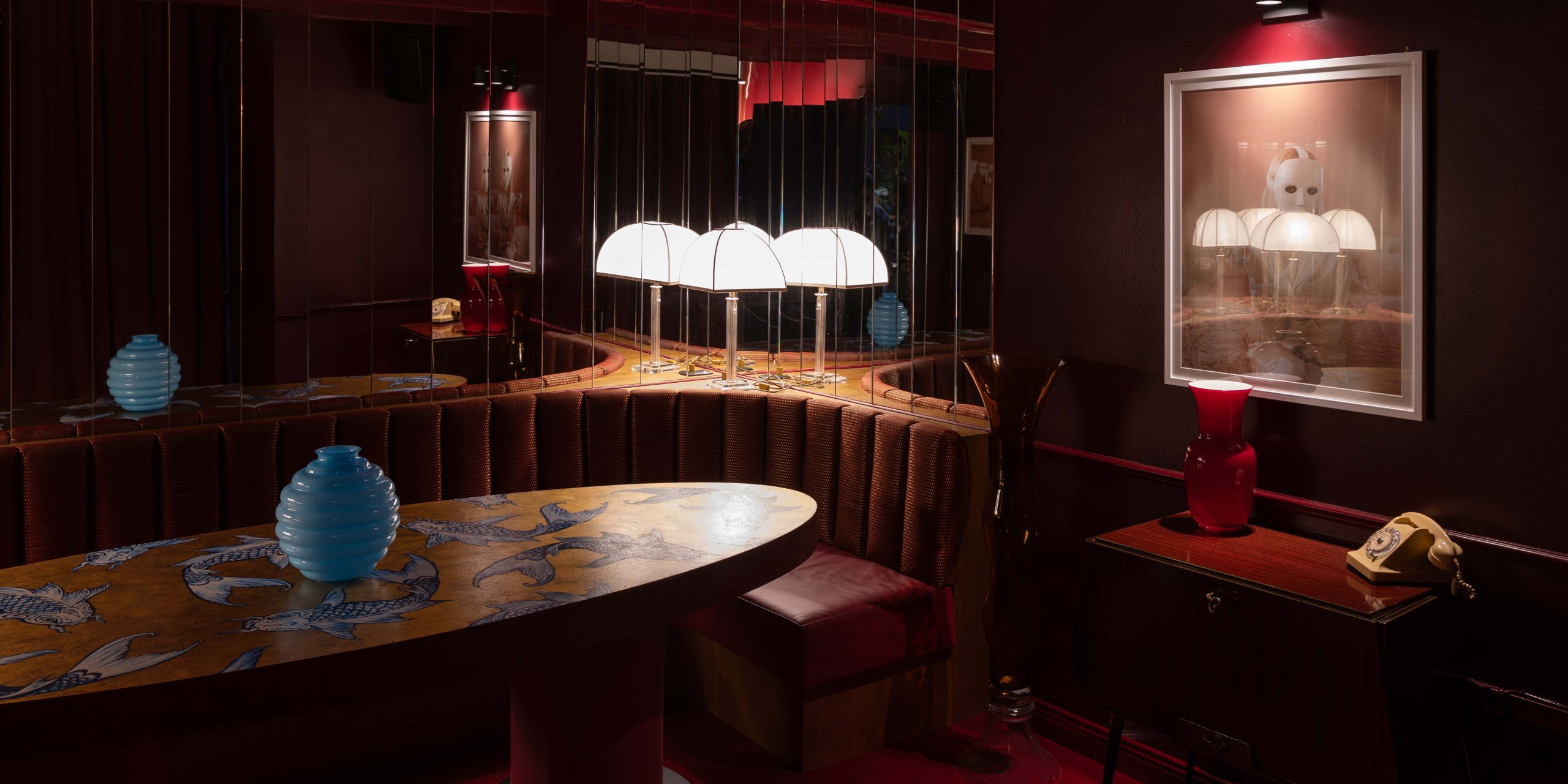 The Best Bars in Milan — 8 Instantly Iconic Drinking Spots You'll Regret Not Knowing While Planning a Camera Roll-Worthy Aperitivo
The Best Bars in Milan — 8 Instantly Iconic Drinking Spots You'll Regret Not Knowing While Planning a Camera Roll-Worthy AperitivoIn the Italian design capital, it's always cocktail o'clock. But what are the best Milan bars? Scroll to discover our style-led edit
By Gilda Bruno
-
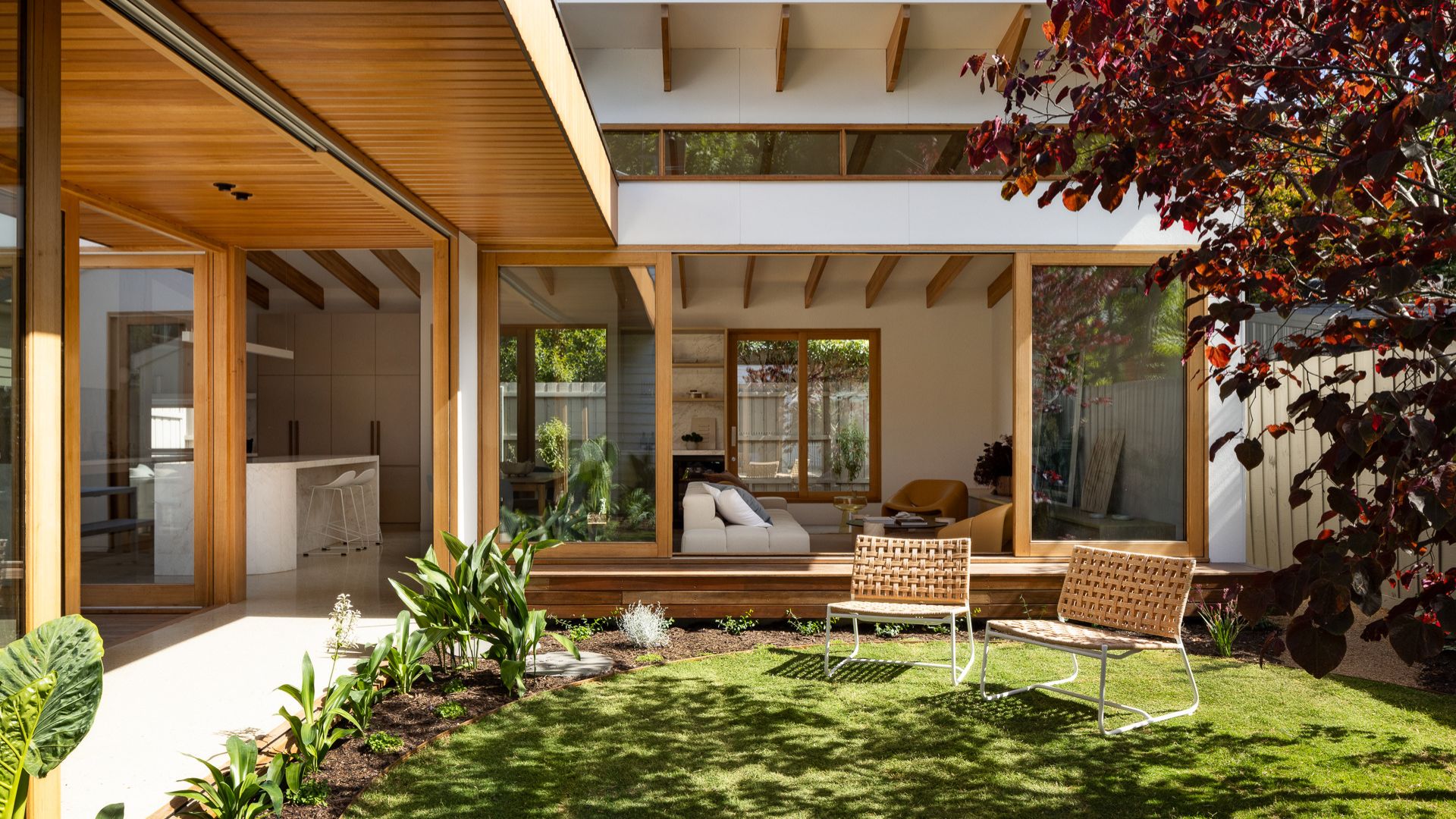 10 Things to Throw Out of Your Garden — Because You Don't Actually Need Them and They're Ruining Your Vibe
10 Things to Throw Out of Your Garden — Because You Don't Actually Need Them and They're Ruining Your VibeBefore you get to hosting in your garden, it might be due for a proper decluttering. Here's a checklist from landscape designers to tidy the space.
By Amiya Baratan
-
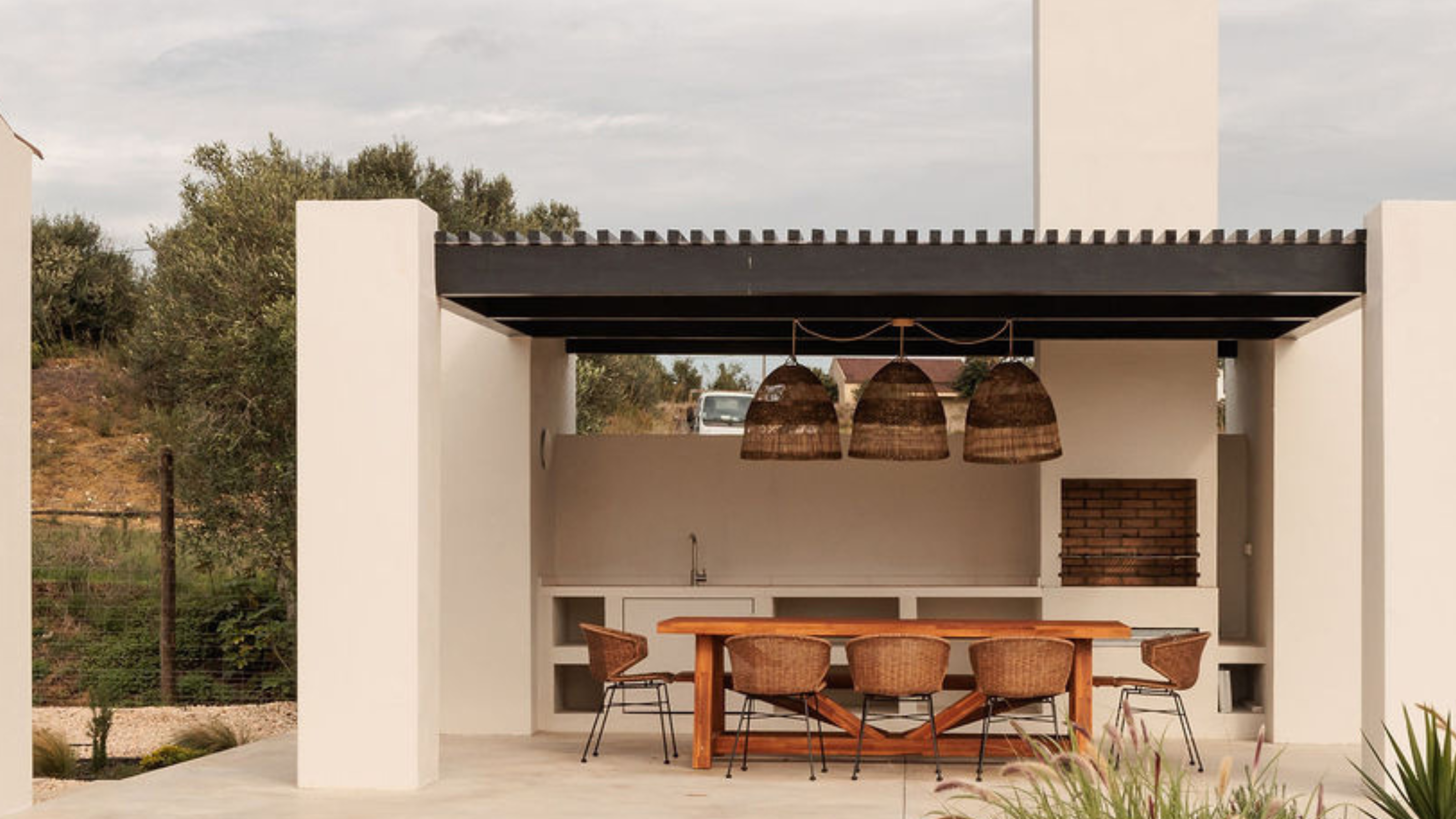 5 Outdoor Kitchen Mistakes to Avoid This Season — Especially If You Want the Best Al Fresco Dining Experience
5 Outdoor Kitchen Mistakes to Avoid This Season — Especially If You Want the Best Al Fresco Dining ExperienceBefore you send out the invites for your summer barbecue, make sure your outdoor cooking area is up to scratch with these expert tips.
By Maya Glantz
-
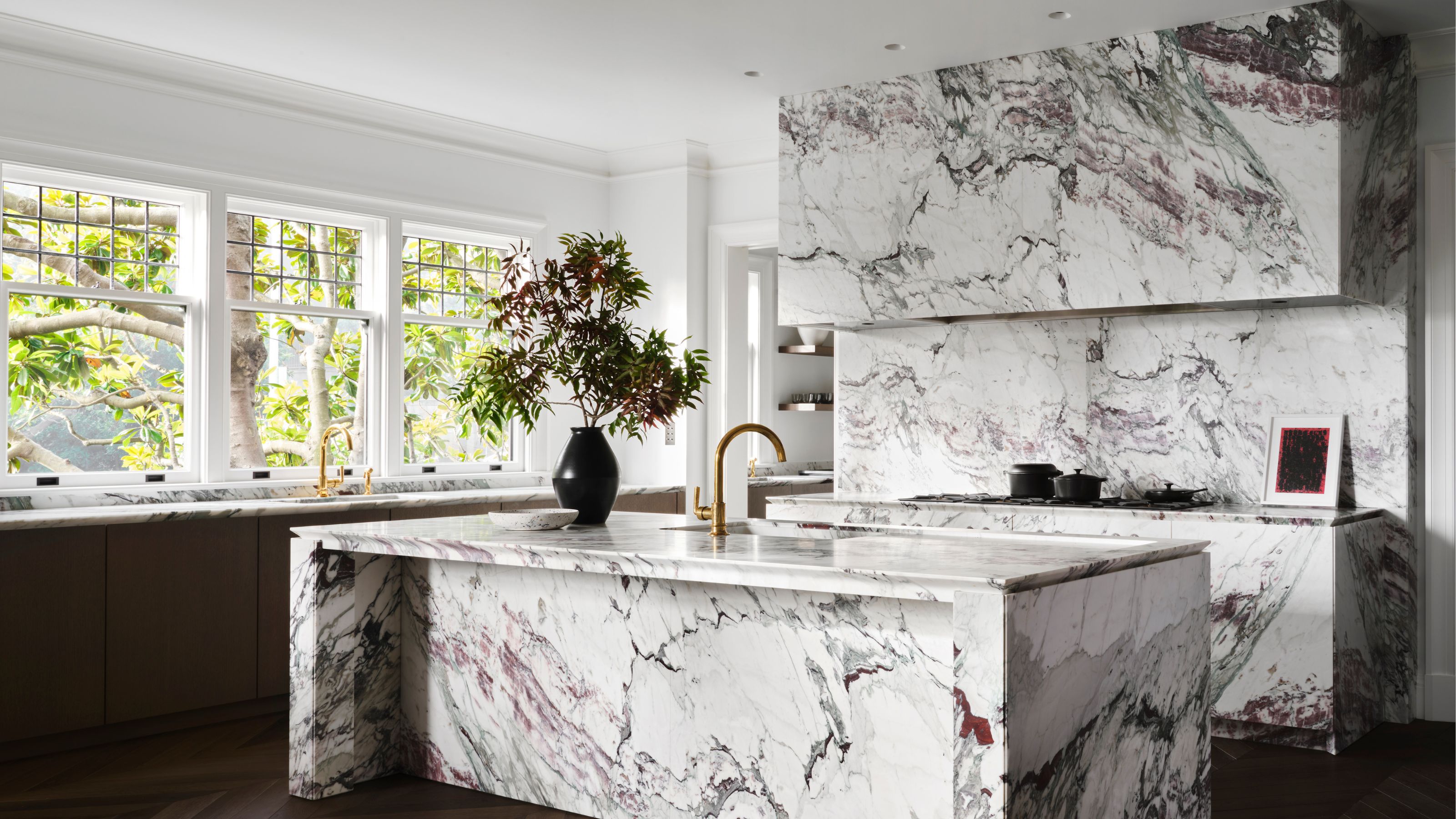 3 Kitchen Stone Trends You'll Want to Copy in 2025 — Experts Highlight the Show-Stopping Finishes Taking Center Stage
3 Kitchen Stone Trends You'll Want to Copy in 2025 — Experts Highlight the Show-Stopping Finishes Taking Center StageLet’s be honest: there’s nothing more lasting and versatile for kitchen surfaces than stone. These are the timeless choices you should make in 2025
By Aditi Sharma
-
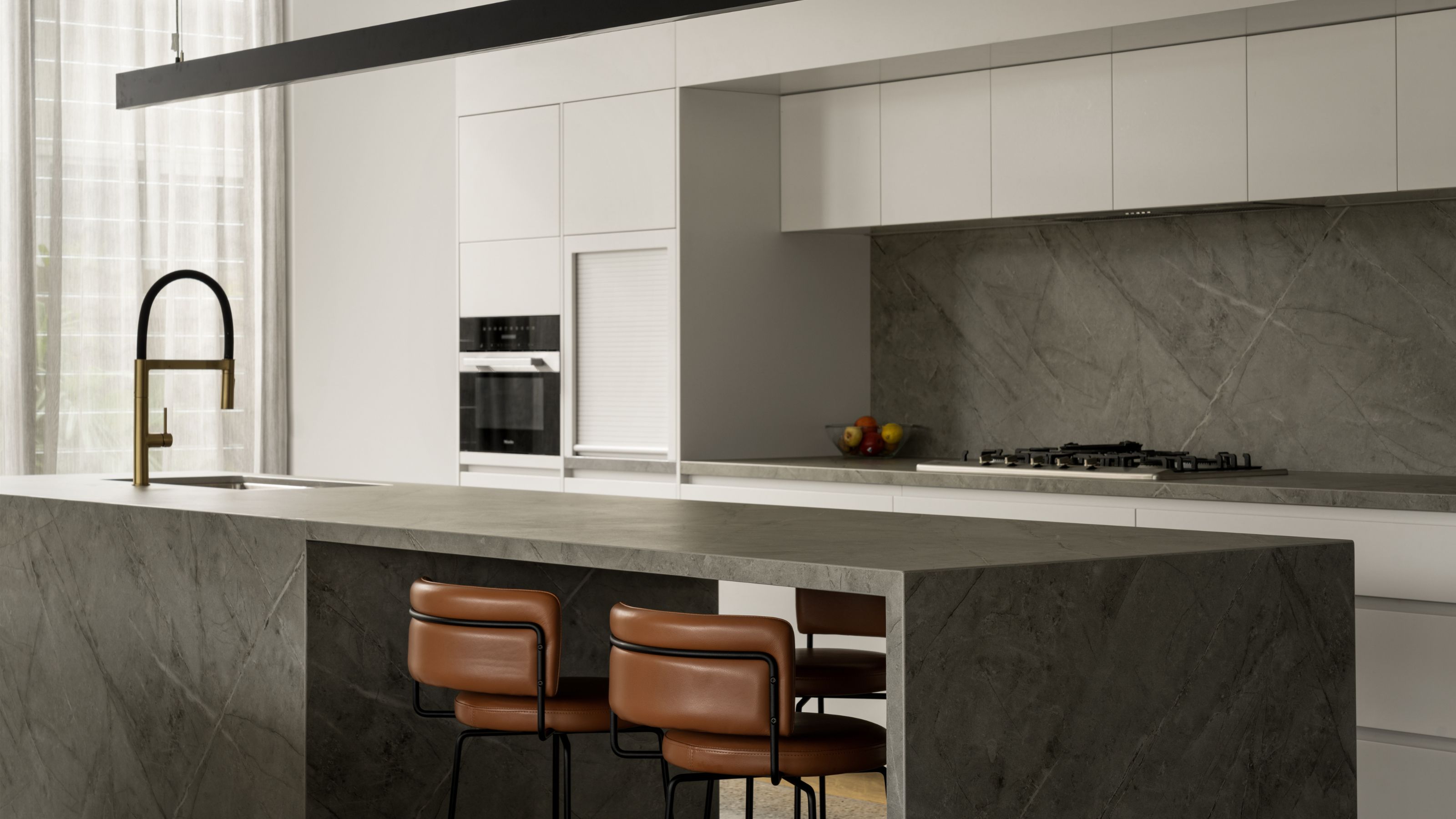 Should You Choose a Kitchen Island or a Breakfast Bar? Experts Weigh-in on the Debate
Should You Choose a Kitchen Island or a Breakfast Bar? Experts Weigh-in on the DebateThey may look alike, but designers break down the real differences in form, function, and everyday practicality
By Aditi Sharma
-
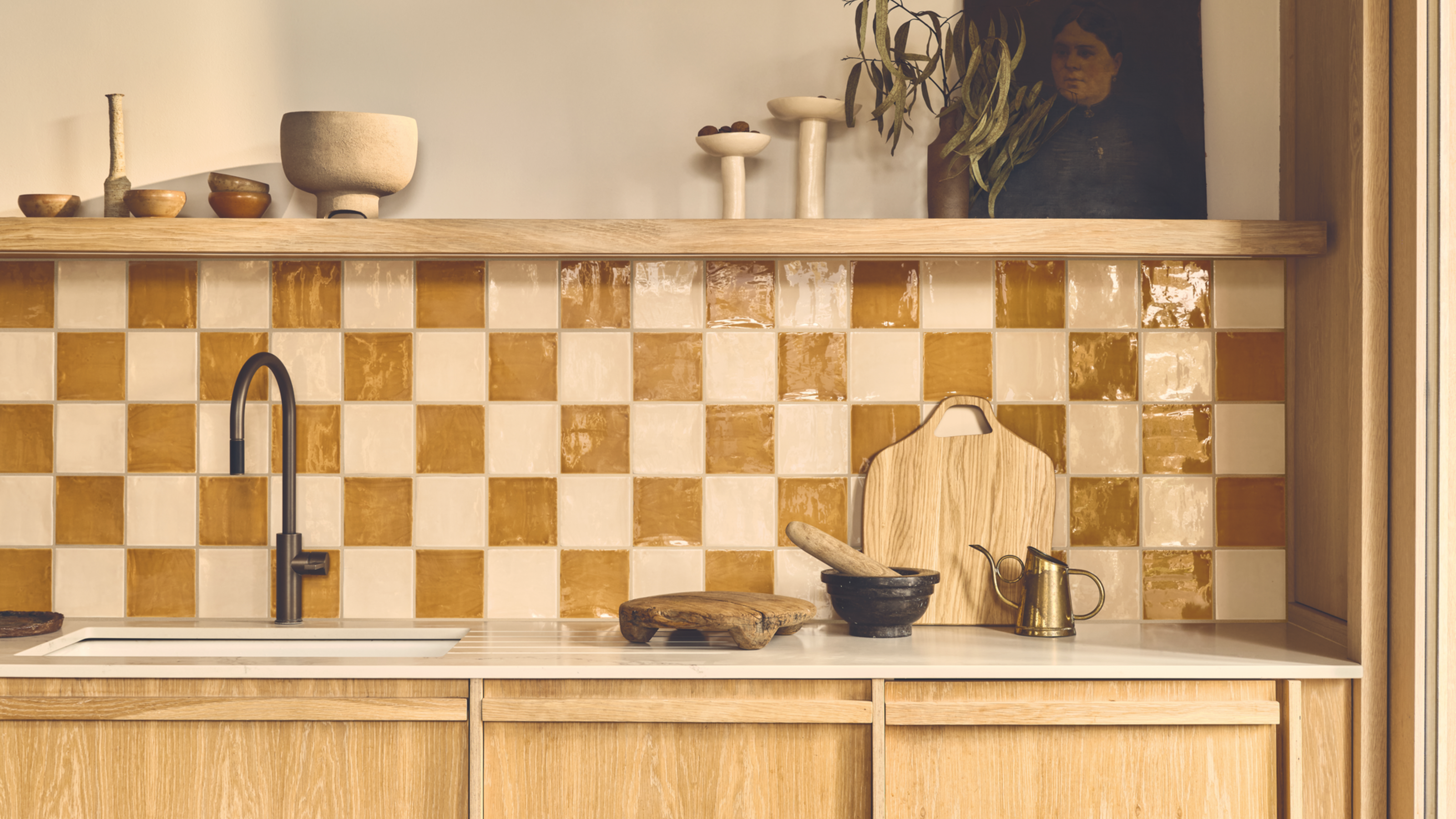 6 Mistakes That Are Making Your Kitchen Tiles Look Cheap and Not Elevated — And What You Can Do Instead
6 Mistakes That Are Making Your Kitchen Tiles Look Cheap and Not Elevated — And What You Can Do InsteadFrom size and grout to color and configuration, here's where you're going wrong with your kitchen tiling
By Lilith Hudson
-
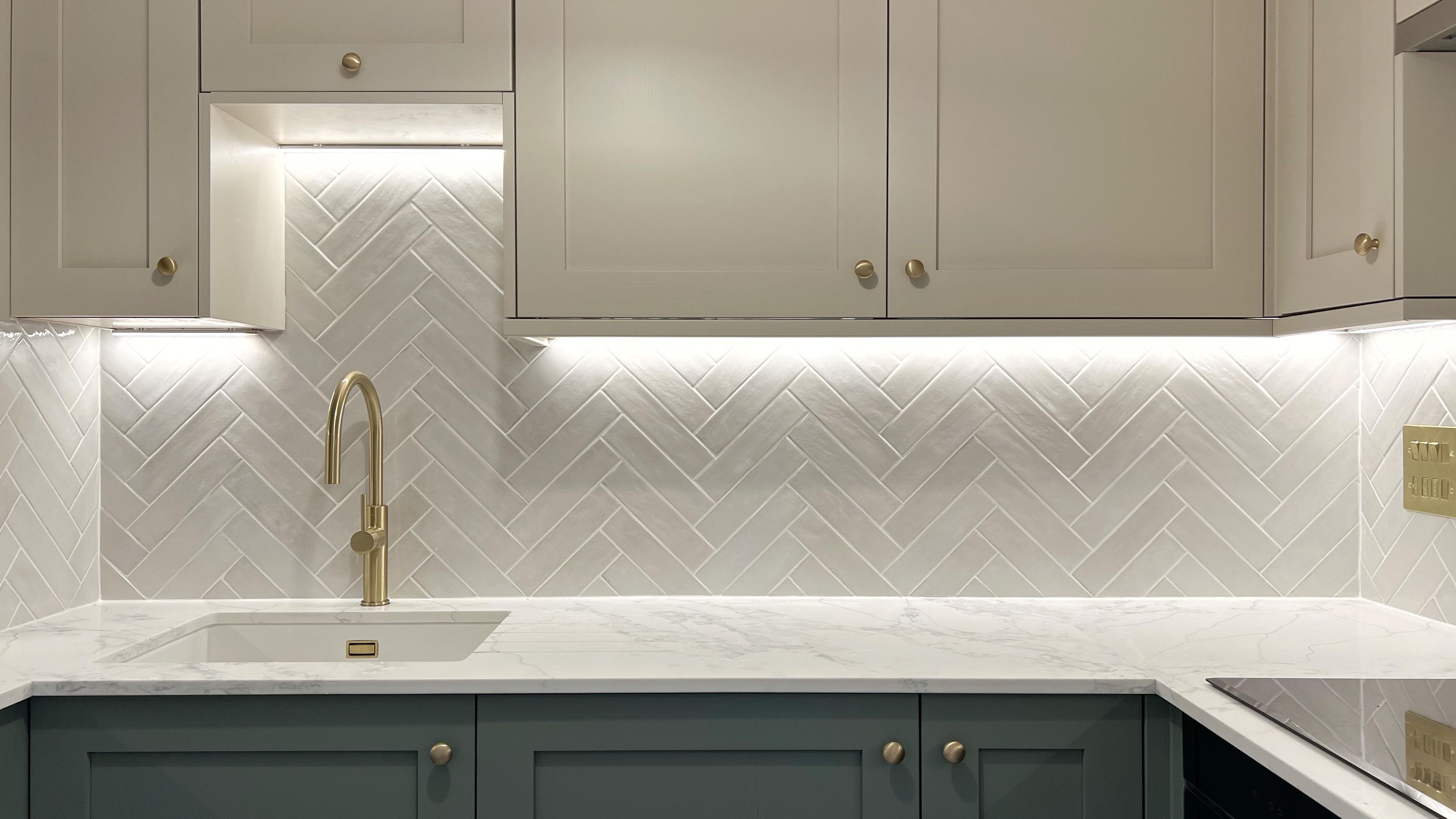 3 Things I Wish I Knew Before Renovating My Small Kitchen — Number One? Always Be Prepared...
3 Things I Wish I Knew Before Renovating My Small Kitchen — Number One? Always Be Prepared...After taking on my own small kitchen project recently, here are the main takeaways I've learned for the next time I renovate one
By Faiza Saqib
-
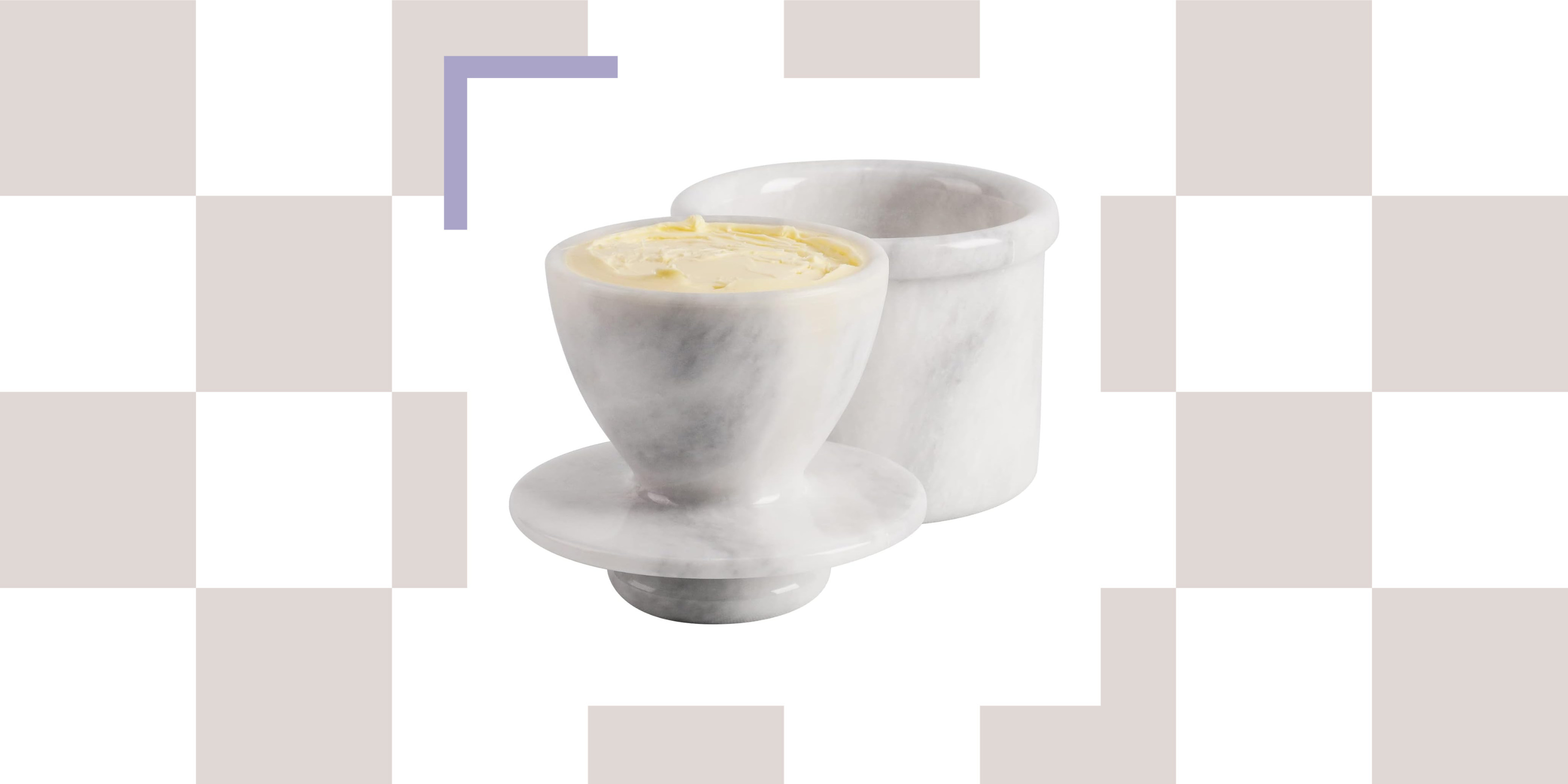 Good Cooks With Even Better Style Are All Putting French Butter Keepers on Their Kitchen Counters — Here's Why
Good Cooks With Even Better Style Are All Putting French Butter Keepers on Their Kitchen Counters — Here's WhyThe French way of storing butter will guarantee soft, spreadable deliciousness at any given moment. I present to you, the butter crock.
By Amiya Baratan
-
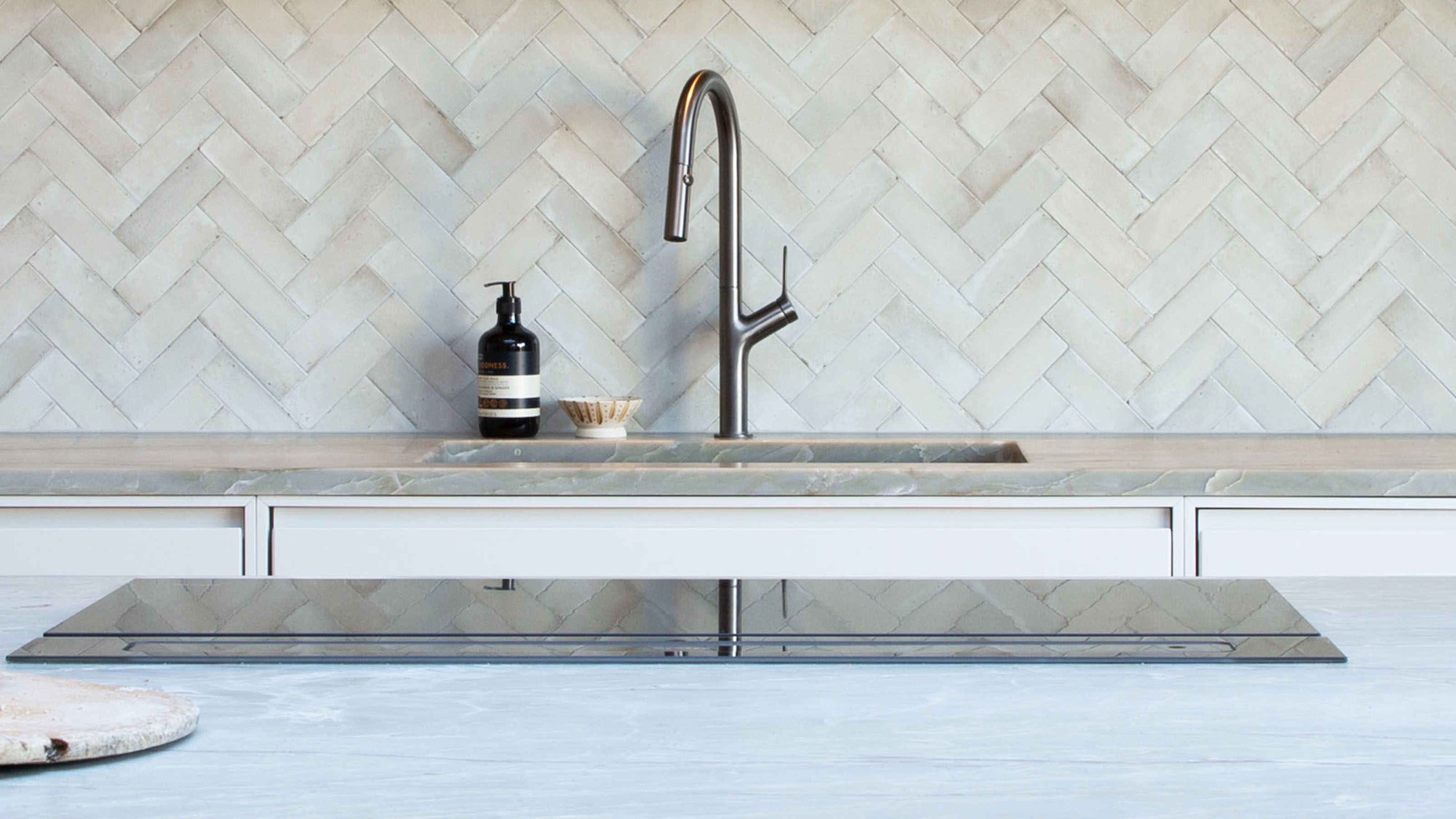 7 Kitchen Tap Mistakes You’re Making That Can Make Your Space Look Outdated — And What to Do Instead
7 Kitchen Tap Mistakes You’re Making That Can Make Your Space Look Outdated — And What to Do InsteadCould it be that your choice of kitchen tap is causing your kitchen to look old-fashioned? Here's what the experts say
By Linda Clayton
-
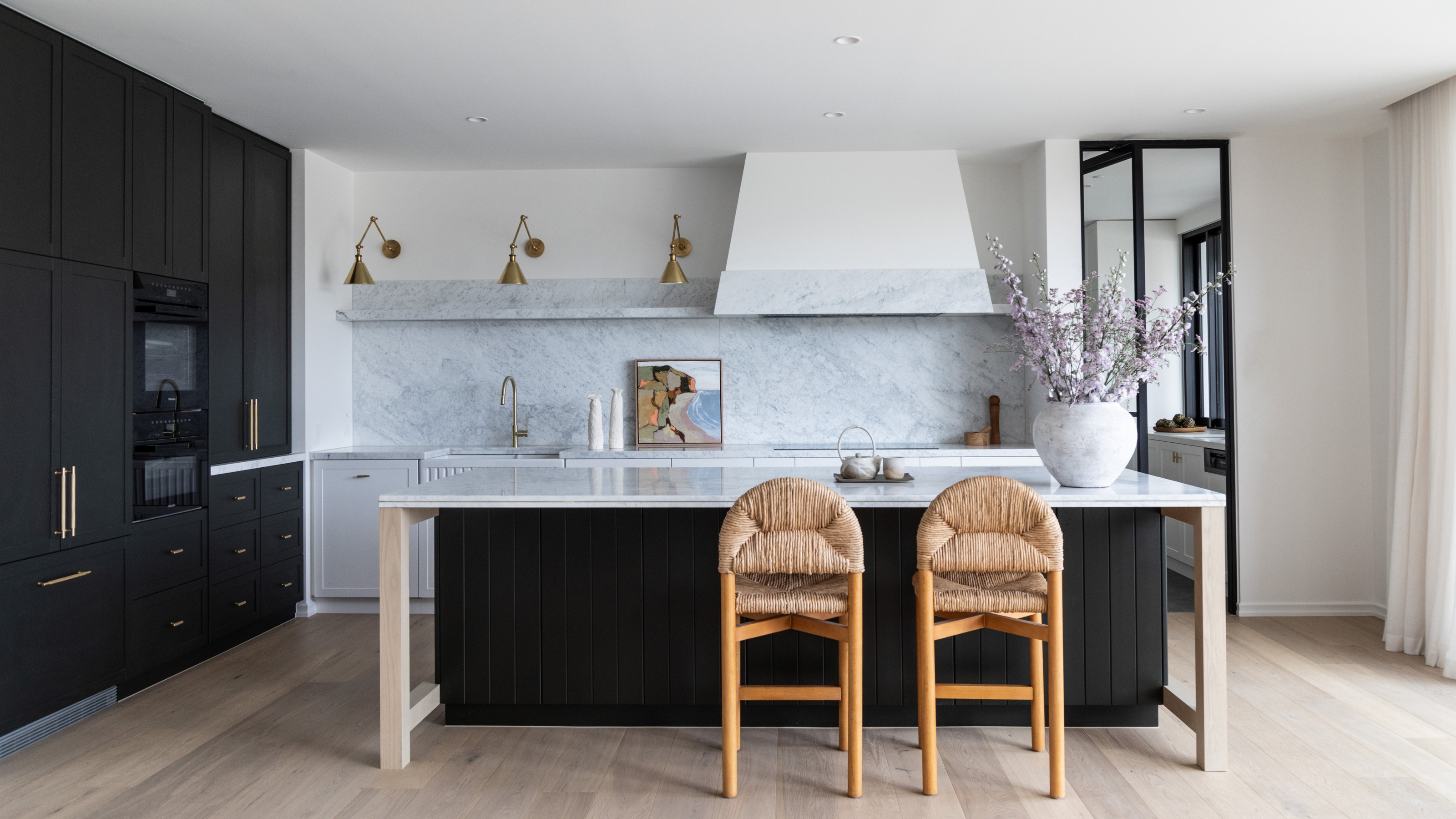 3 Kitchen Island Measurements That the Best Designers Always Use When Planning Spaces
3 Kitchen Island Measurements That the Best Designers Always Use When Planning SpacesYour cheat-sheet guide to getting clued up on all the basics of island measurements, straight from the experts.
By Maya Glantz
